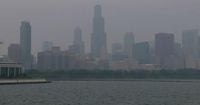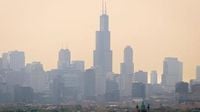On Thursday, June 5, 2025, residents of Chicago and its surrounding suburbs woke up to a sky thick with smoke drifting south from over 100 wildfires raging across Canada. The dense haze reduced visibility and pushed air quality to dangerous levels, prompting a series of alerts and warnings from health and environmental officials.
Liam Heneghan, standing on Lee Street Beach in Evanston with his 2-year-old granddaughter Iphie, noticed the usual outline of the Chicago skyline obscured by the smoky veil. “It feels like a very fresh day,” he said, “that’s very often what’s deceptive about this sort of pollution.” Despite the seemingly benign atmosphere, Chicago’s air quality was among the worst worldwide, with the city ranking as the second most polluted major city globally at times during the day, according to IQ Air, a Swiss air-technology company.
The Illinois Environmental Protection Agency (EPA) declared an Air Pollution Action Day for the Chicago area, effective until midnight Friday, June 6. This action covers Cook, DuPage, Kane, Kendall, Grundy, Lake, McHenry, and Will counties. The National Weather Service extended the air quality alert through Friday, warning residents that the air contained elevated levels of particle pollution, also known as PM2.5—microscopic contaminants capable of embedding deep in human lungs and posing severe health risks.
By midday Thursday, Chicago’s Air Quality Index (AQI) reached 163, firmly in the “unhealthy” red category, with similar readings across the north, west, south, and western suburbs. For context, an AQI between 0 and 50 is considered “good,” while values above 150 signal unhealthy conditions for the general population. Some sensors in Chicago and nearby northwest Indiana even recorded levels “unhealthy” for everyone, not just sensitive groups.
Despite the thick haze blanketing the city, many downtown residents reported barely sensing the smoke’s presence. However, health experts caution that the invisible particles can be more harmful than apparent. Dr. Brady Scott, a respiratory therapist and professor at Rush University Medical Center, urged caution, especially for seniors, children, and those with respiratory or heart conditions. “Thursday is a day to be very cautious about going outside,” he said. Symptoms to watch for include coughing, wheezing, chest pain, fatigue, and shortness of breath. If these worsen, medical attention should be sought immediately.
Dr. Alexander Sloboda of the Chicago Department of Public Health echoed these warnings, advising residents to limit outdoor activities and keep children indoors. Chicago Public Schools sent letters home recommending students minimize time outside. Sloboda also emphasized the importance of proper masks, stating, “It needs to be an N95 because those particles are so small.” He added that air conditioners with filters and air purifiers could help improve indoor air quality by circulating and filtering the air.
The smoke originated from over 100 wildfires burning in Canada’s provinces of Saskatchewan, Manitoba, and Quebec, where officials declared a state of emergency. These fires began in mid-May and have forced over 33,000 people to evacuate, with two fatalities reported so far. The Canadian government attributes the intensity and early start of the fires to hot, dry conditions exacerbated by climate change, a phenomenon that experts warn may become the new normal.
“These sorts of conditions are kind of troubling manifestations of a world on fire,” said Heneghan, expressing concern for future generations like his granddaughter. “She’s entering into a world where the past is not going to be a reliable guide to the future.”
Weather patterns have played a significant role in the smoke’s impact on Chicago. Meteorologist Kevin Doom of the National Weather Service explained that northern winds have carried the smoke southward over the last several days, settling over the Midwest and Great Lakes region. A temperature inversion over Lake Michigan has trapped cooler air near the surface, preventing vertical mixing and allowing pollutants to accumulate. This phenomenon causes poorer air quality in Chicago compared to some western suburbs where the lake’s influence is weaker.
Tom Skilling, recently retired chief meteorologist at WGN, elaborated on the climate factors behind the wildfires. “The clarity in which these wildfire events are occurring over the United States and southern Canada is a byproduct of our warming climate and changing precipitation patterns,” he said. “The moisture situation in Canada this year is one of below normal precipitation. So you set the stage for these fires when it’s dry and on top of that you put abnormally mild or warm temperatures over the area then you get into deep trouble.”
Skilling noted that while the smoke is expected to begin thinning as winds shift, the fires themselves are far from contained. “We’ve got some time left where we’re gonna have some pollution, some air quality issues here.” He stressed the importance of adapting to these environmental changes, saying, “We all breathe air, and so modifying our exposure to the bad air is a good way to proceed.”
Similar air quality challenges extended beyond Chicago. Cities like Detroit, Lansing, Grand Rapids, and Gary, Indiana, also reported “code red” or “code orange” levels of pollution. The smoke plume has been drifting southeast since early June, moving from the Dakotas through Minnesota, Wisconsin, and now the Great Lakes region. While particulate concentrations are expected to decrease by the weekend, moderate to locally severe pollution may persist, especially near the Canadian border.
The Illinois EPA advised residents to limit driving, conserve energy, and avoid gasoline-powered equipment to reduce pollution further. They also recommended grouping errands and using public transit or carpooling to minimize emissions. The National Weather Service cautioned against strenuous outdoor activities, particularly for vulnerable groups, until air quality improves.
On the ground, the smoky haze mingled with fog in parts of Illinois, reducing visibility and creating eerie sunrises and sunsets reminiscent of past wildfire seasons. Despite the discomfort and health risks, many Chicagoans are adapting, staying indoors, and using air filtration devices to cope with the polluted air.
As climate change continues to fuel more frequent and intense wildfires, experts warn that events like this may become a regular challenge. Dr. Sloboda noted, “We could see more events like this in the near future. So we definitely need to do more to educate and prepare people.” The Chicago Department of Public Health plans to analyze hospital data to assess the impact of the smoke on respiratory and cardiovascular health.
For now, Chicagoans are urged to stay informed through resources like AirNow.gov, which provides real-time air quality updates, and to take all necessary precautions to protect themselves and their families from the lingering effects of wildfire smoke.





